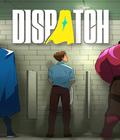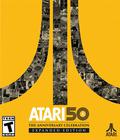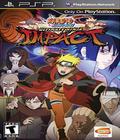PSP players should be familiar with the Naruto Shippuden franchise. The continuation of the original Naruto stories, the game series has used the portable system as a breeding ground for different ways to tell essentially the same story. PSP-owning Naruto fans have played or seen it all, including fighting games, adventure games and even a multiplayer RPG-like game. In what could be the last game in the series for the PSP, Namco Bandai Games decided to give the series one more go as an adventure game with Naruto Shippuden: Ultimate Ninja Impact. While it still doesn't reach the heights of the console games, it is one of the better Naruto games on the PSP.
Like two of the other three Naruto Shippuden games on the PSP already, this one starts off with the beginning of the series as Naruto returns to the Hidden Leaf Village after a three-year training session. Despite the happy reunion, Naruto finds himself in the thick of things once again as the story goes from the Gaara rescue arc all the way to the Five Kage Summit arc.
At its core, Ultimate Ninja Impact is an adventure game similar in scope to Akatsuki Rising, where most levels are self-contained rooms blocked off by requirements, such as killing all of the enemies in the room before being allowed to progress. The camera angle is still placed squarely behind the player, though it is pulled back so you can see more of your surroundings. You have the ability to jump now, and your attacks consist of ranged (with shurikens) and melee, both of which can be modified with chakra. There are a decent number of combos, all of which are activated with a combination of attack buttons and chakra modifications thrown in at the right time. At first glance, things would feel familiar to those who have played some of the previous PSP games.
Once you enter combat, you'll see one of the gameplay changes. The game apes Dynasty Warriors by having your fighter go up against hordes of enemies at seemingly the same time. Your moves, once designed to hit only one enemy at a time, can suddenly make contact with several enemies at once. These enemies have energy meters so low that you can wipe out a good number of them with one combo. Despite their numbers, very few bother to actually attack you. One foe may get in a few hits, but most prefer to simply crowd around you and wait for their turn to get attacked. There are jars on the battlefield that contain some power-ups ranging from health boosts to extra attack or defense power, but their effects only last until the end of the level. In short, one could describe this title as being more than just a little influenced by Tecmo/Koei's brawling franchise.
That isn't to say that Ultimate Ninja Impact completely mimics everything from the Dynasty Warriors series. For example, no one can ride on vehicles or animals. Though a few levels feature subordinates that must be defeated, there isn't the need for a territory grab since there are no outposts that need to be taken over before you can attack the final boss. Though the layout is similar, levels aren't as large, so traversing them doesn't feel like a long trek every time. Finally, while some levels feature a time limit, most levels allow you to play at your own pace.
The other big change is the use of cards. Once a level is completed, you get a number of card pieces depending on your performance in that level. Once completed, the cards come equipped with stat or action benefits that vary depending on type and card level. Once in the overhead map screen, you can select any unlocked character and equip him with up to four different cards to augment his regular abilities. While the cards are static, each character has own card which, when equipped, can level up alongside the character to provide even better boosts later.
The card system adds some depth to the general gameplay since you can augment your favorite fighter in many ways, but the real hook comes in the fact that, with the exception of specific cards you purchase from shopkeepers, all of the card pieces received from battles and opening bought packs are completely random. That random nature helps feed into the addictiveness of playing, since you always hope for better card pieces and cards to show up , making you want to replay levels to get a chance at those much-needed pieces. With this in place, the game encourages replayability, which was barely present in the previous PSP entries.
There are two other modes outside of the main campaign, though there isn't much of a difference between them. The Extra Missions open up once you complete the first act of the game and act as side stories and "what-if?" missions that fill in the time between the main story missions. Co-Op missions have you replaying certain chapters of the story with a computer-controlled partner in tow. Both give you the same mission parameters as other quests, and you'll still get gold and card pieces for completing them, making them good for accomplishing those tasks and nothing more.
As far as the single-player game goes, there are a number of flaws that bring down the game. The droning cut scenes that feature nothing but still pictures of characters talking to each other has become a staple of anime games, but it doesn't mean that it is preferred over fully animated cut scenes. As stated before, the enemy AI doesn't want to do much to attack you, but in most cases, your partner also refuses to do anything. This doesn't mean that you'll lose badly on levels where your partner needs to survive, but that just means the burden of doing any work always rests on your shoulders. Finally, the game offers to install a rather hefty 400MB on your memory stick for faster load times. That is a lot of space to take up, but opting not to do so means that load times will be exceptionally long. It also has the adverse effect of making awkward transitions from regular fights to the Quick Time Events (QTEs) on boss battles since you'll be staring at a transitional character blur for a while, making you wonder if the game has crashed.
Multiplayer has been pared down for this release. Unlike Kizuna Drive, which allowed four-player action, this title only has two players going through missions together. Even then, both players can only go through special co-op missions that are unlocked once players complete certain portions of the single-player campaign. While this may be good for those who love co-op play, those looking to pit their powered-up characters against one another will be disappointed by the lack of versus multiplayer. With the nature of the game being loot-based once missions are complete, the idea of multiplayer seems more appealing since replaying missions has more meaning. Like older titles, there is no online multiplayer, but the performance of local multiplayer is excellent.
The sound presents a few issues that weren't in previous games. The music sounds exactly the same as before, with battle and menu themes sounding being familiar to series veterans. The sound effects remain good and come out clearly. The user still has the choice of hearing an English or Japanese voice track, and since the voice actors are the same ones used in the series, you can expect the quality and delivery to be the same. The voices, however, also become the source of some of the issues. Most of the attack shouts come out more muffled than clear. Also, all of the characters have the bad habit of repeating lines throughout each mission. The first time you hear the line, it creates a good atmosphere, but by the seventh time you hear someone praising Kakashi-sensei's skills or Naruto wondering how he got involved in a messy situation, you'd prefer that the characters had stayed mute.
Similarly, the graphics take on the style of older titles but throw in a few issues of their own. The characters are still cel-shaded with some pretty thick black outlines. Their animations are smooth and fluid, considering the number of characters on-screen at the same time. The observation also holds true during scenes where large characters are in play, and the frame rate holds steady during these times. The overall colors are as bright as the anime, and the backgrounds follow suit. Speaking of backgrounds, most of them look like they came out of the previous games, so they feel familiar. The big gaffe with the graphics comes from the environments in that there is some pretty bad fade-in as you go through each level. Incoming enemy hordes do the same thing, but it's certainly more noticeable when the pieces of the environment suddenly form in front of you as you move. Since the effect never happened in earlier Naruto PSP titles, it is disappointing to see it here.
Naruto Shippuden: Ultimate Ninja Impact is a technically flawed game but features some solid gameplay and is better than past Naruto PSP titles. The Dynasty Warriors gameplay suits the franchise well, though it could have used better and more aggressive AI on both sides. The card-collecting aspect throws in a loot system that will certainly appeal to collectors and fans of Diablo-style games, and there is enough replayability to get plenty of mileage from the game. Had an adversarial mode been thrown in along with some improvements to both graphics and sound, it would have made the game a strong recommendation for action fans of all types. As it stands, it is certainly made for Naruto fans.
Score: 7.0/10
More articles about Naruto Shippuden: Ultimate Ninja Impact











 Featuring large-scale battles against massive groups of enemies, Naruto Shippuden: Ultimate Ninja Impact puts players in the middle of epic fights as their favorite Naruto Shippuden characters through electrifying single-player and multiplayer modes.
Featuring large-scale battles against massive groups of enemies, Naruto Shippuden: Ultimate Ninja Impact puts players in the middle of epic fights as their favorite Naruto Shippuden characters through electrifying single-player and multiplayer modes.











































